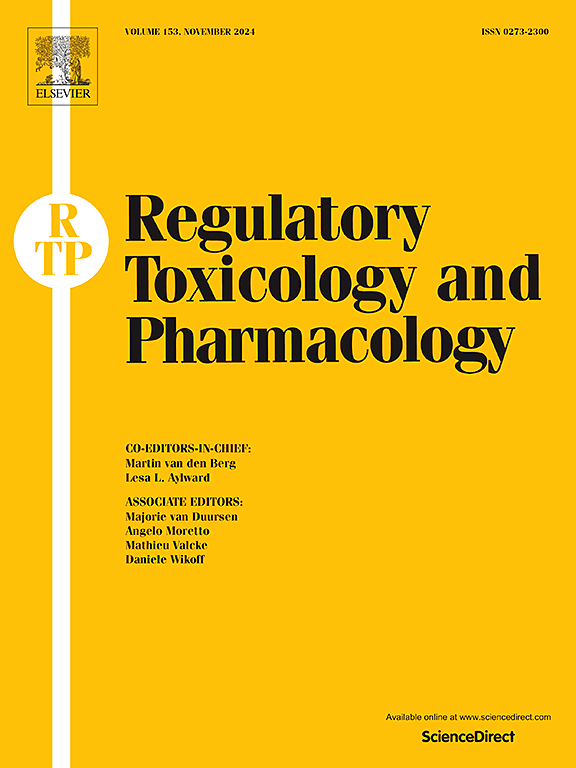Rethinking the necessity of long-term toxicity studies for biotherapeutics using weight of evidence assessment
IF 3
4区 医学
Q1 MEDICINE, LEGAL
引用次数: 0
Abstract
The registration of biotherapeutics for chronic indications requires 6-month toxicity studies. However, extensive experience has shown that the non-clinical safety profiles of biotherapeutics are generally predictable. This suggests that conducting multiple studies, especially a 6-month study may not be necessary. In a meta-analysis of biologics developed for non-oncology indications over last 25 years at Pfizer, we compared organ system findings between short-term (1–3 month) and long-term (6-month) animal studies. Our goal was to determine if there were differences in the safety profiles between the two study durations and their relevance to human risk assessment. Our analysis revealed that most clinically relevant toxicities could be detected in shorter-term studies (87%; 26/30 programs). This suggests either an undifferentiated safety profile between short-and long-term studies, or anticipated toxicities based on the modality, such as immunogenicity or exaggerated pharmacology. However, for 4 out of 30 programs (13%), long-term studies did identify either potential new toxicities or more severe manifestation of exaggerated pharmacology, leading to modifications in clinical trial designs and human risk assessment. Our experience suggests that 3-month toxicity studies may be sufficient to support late-stage clinical development for a majority of standard biotherapeutic programs. This pragmatic and science-based approach aligns with the goal of advancing 3R's initiatives in nonclinical safety assessment.
利用证据权重评估重新思考生物治疗药物长期毒性研究的必要性。
慢性适应症生物疗法的注册要求进行为期 6 个月的毒性研究。然而,丰富的经验表明,生物治疗药物的非临床安全性概况通常是可以预测的。这表明,进行多项研究,尤其是为期 6 个月的研究可能并无必要。在辉瑞公司过去 25 年针对非肿瘤适应症开发的生物制剂的荟萃分析中,我们比较了短期(1-3 个月)和长期(6 个月)动物研究的器官系统结果。我们的目标是确定两种研究期限的安全性是否存在差异,以及它们与人体风险评估的相关性。我们的分析表明,大多数与临床相关的毒性可在短期研究中检测到(87%;26/30 个项目)。这表明,短期和长期研究的安全性特征并无差别,或者是基于模式的预期毒性,如免疫原性或夸大的药理作用。不过,在 30 个项目中,有 4 个项目(13%)的长期研究确实发现了潜在的新毒性或更严重的夸大药理表现,从而导致临床试验设计和人体风险评估的修改。我们的经验表明,3 个月的毒性研究可能足以支持大多数标准生物治疗项目的后期临床开发。这种以科学为基础的务实方法与推进 3R 计划的目标不谋而合。
本文章由计算机程序翻译,如有差异,请以英文原文为准。
求助全文
约1分钟内获得全文
求助全文
来源期刊
CiteScore
6.70
自引率
8.80%
发文量
147
审稿时长
58 days
期刊介绍:
Regulatory Toxicology and Pharmacology publishes peer reviewed articles that involve the generation, evaluation, and interpretation of experimental animal and human data that are of direct importance and relevance for regulatory authorities with respect to toxicological and pharmacological regulations in society. All peer-reviewed articles that are published should be devoted to improve the protection of human health and environment. Reviews and discussions are welcomed that address legal and/or regulatory decisions with respect to risk assessment and management of toxicological and pharmacological compounds on a scientific basis. It addresses an international readership of scientists, risk assessors and managers, and other professionals active in the field of human and environmental health.
Types of peer-reviewed articles published:
-Original research articles of relevance for regulatory aspects covering aspects including, but not limited to:
1.Factors influencing human sensitivity
2.Exposure science related to risk assessment
3.Alternative toxicological test methods
4.Frameworks for evaluation and integration of data in regulatory evaluations
5.Harmonization across regulatory agencies
6.Read-across methods and evaluations
-Contemporary Reviews on policy related Research issues
-Letters to the Editor
-Guest Editorials (by Invitation)

 求助内容:
求助内容: 应助结果提醒方式:
应助结果提醒方式:


